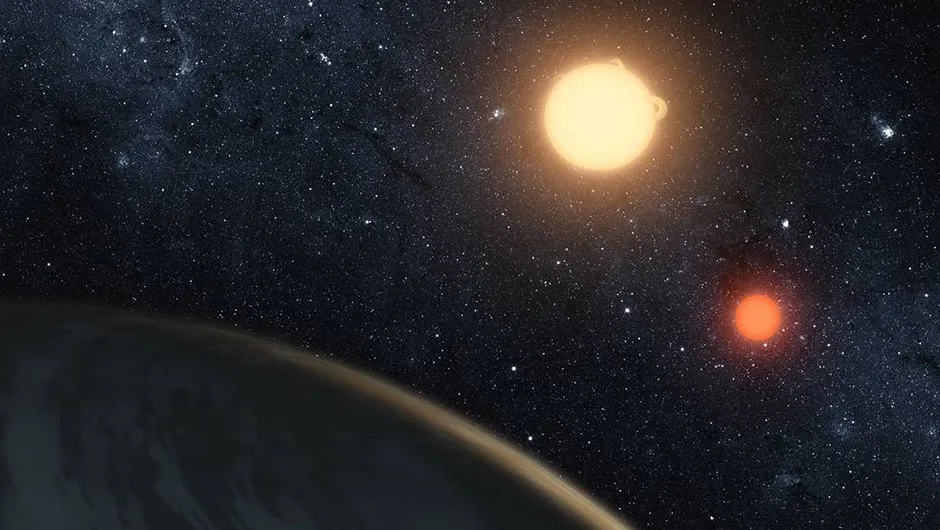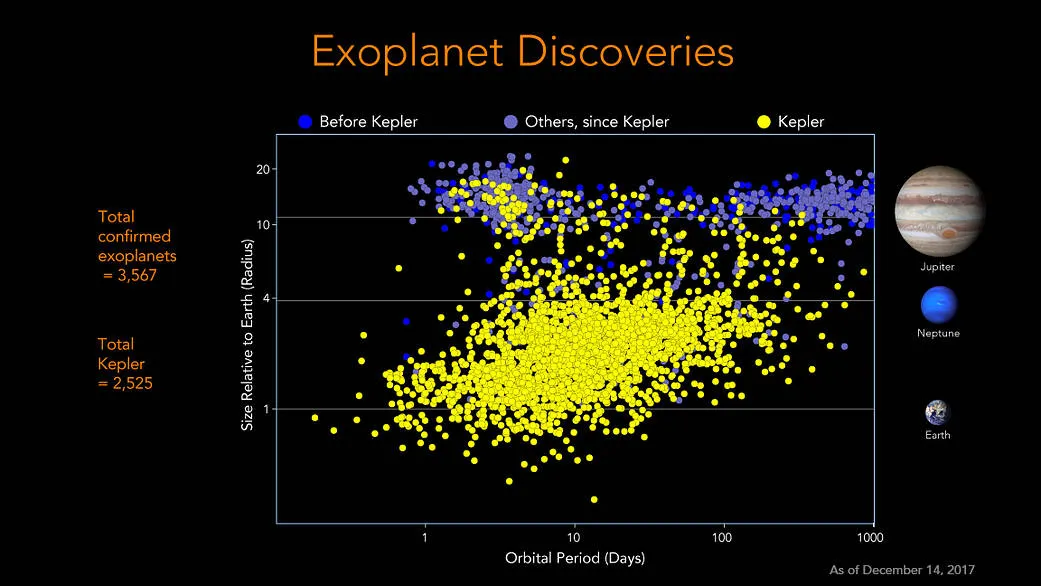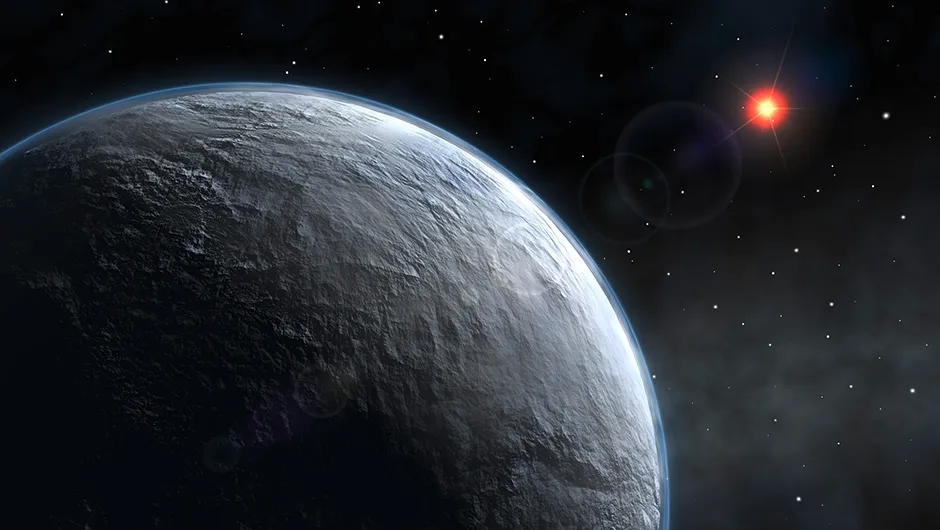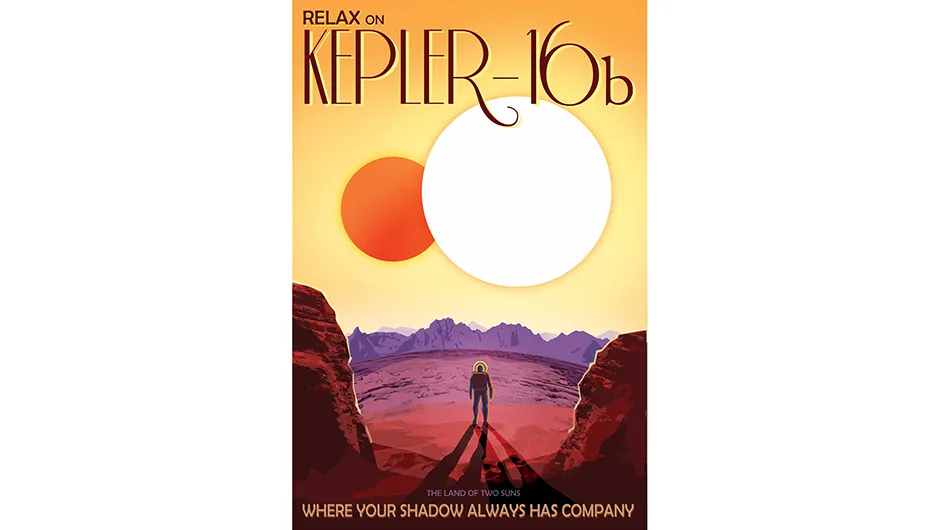Jakku. Tatooine. Hoth. Planet names familiar to aficionados of that galaxy far, far away. But what of Kepler-16b, 51 Pegasi b, or even OGLE-2005-BLG-390Lb? They’re the given names of exoplanets found orbiting other stars in our Milky Way Galaxy.
Sure, the Star Wars saga got there first. It helped conjure up a compelling picture of what inhabited planets might look and sound like.
But now scientists are finding that our stellar neighbourhood is filled with exoplanets. Many of them are as exotic as anything in the saga. Some even bear more than a passing resemblance to their fictional counterparts.
Making Sense of the Milky Way
Before wading through the weird and wonderful worlds that have been found out in deep space, it’s useful to start the journey in our own backyard. After all, our Solar System acts as a neat yardstick against which other systems can be gauged.
In our system, there are two kinds of planets: rocky and gassy. The basic difference is this: on rocky planets, there’s somewhere to land the Millennium Falcon - the ground.
However, gassy planets don’t have ‘grounds’; they just have gas. This makes landing more difficult.
Rocky planets form close to the Sun, in the vicinity of the Goldilocks Zone.
The bigger gassy planets form further out, beyond the frost line, and way into the cold zone. Gassy giants have been found in other systems, too.
As planet-hunters scan the skies for wobbling stars, it was known in advance that bigger planets would mean bigger wobbles.
As massive giants, they simply make larger and more rapid wobbles in their parent star, making their presence easier to detect.
That’s why the vast majority of known exoplanets are so-called ‘hot Jupiters’, or perhaps ‘boiling Bespins’, using Star Wars vernacular.
These hot Jupiters (sometimes also called ‘roaster planets’) are so named as their mass is of Jupiter proportions, but their orbit is much closer to their parent star than Jupiter’s is to the Sun. Between ten and three hundred times closer, in fact.
Being so close to the mother star means that hot Jupiters get their gassy atmospheres stripped away by the heat. So this class of exoplanet is quite unlike the liveable worlds in Star Wars.
And yet, as detection methods got better, scientists began to find exoplanets far more in the Star Wars style.

Consider Kepler-16b
Now consider NASA’s Kepler Mission.
Launched in 2009, the job of the Kepler spacecraft is to spot Earth-like planets among the 155,000 stars in the constellations of Cygnus and Lyra, which are visible from our northern hemisphere.
To date, Kepler is the most exciting exoplanet search mission.
The Kepler space observatory looks for Earth-like planets orbiting Sun-like stars by scanning the sky, looking for mini-eclipses, those tell-tale signs that an exoplanet is crossing in front of its parent star
By using Cygnus and Lyra as examples, the Kepler mission also aims to estimate how many of the billions of stars in our Galaxy may have Earth-like worlds.
What Kepler found is quite incredible.When the Kepler observatory completed its primary mission objectives in 2012, it had detected nearly five thousand exoplanets.
Perhaps its strangest discovery is a so-called Styrofoam planet, a world with just one-tenth the density of Jupiter. And its most stunning discovery is the first confirmation of a rocky planet outside our Solar System.
In 2015, Kepler scientists announced the discovery of Earth’s ‘closest twin’.However, Kepler had also found a Tatooine-like planet in Kepler-16b. Like Tatooine, Kepler-16b enjoys double sunsets, as it circles two stars rather than a single sun.
New research also shows that far from being only merely possible, Tatooine-type planets may actually be quite common.
Scientists confirmed this first unambiguous discovery of a circumbinary planet in 2011, a full thirty-four years afterv its fictional counterpart was dreamt up in A New Hope.
Kepler-16b sits in a system about two hundred light-years from Earth.Its mass is similar to Saturn, which makes it much bigger than Tatooine, whose diameter is only 82 per cent of the Earth’s.
The Kepler-16 stars are small compared to our Sun, at about 69 per cent and 20 per cent of the Sun’s mass.
Tatooine’s binary stars are both roughly Sun-sized. The story of Kepler-16b is a good example of how planet-hunting works. Pictures captured by Kepler’s camera showed two stars orbiting each other. Next, eclipses were seen, where one star moved in front of the other.
However, with a closer inspection, the evidence showed subsequent eclipses that couldn’t be explained by the movement of the two stars alone.
Instead, the tiny drop in light from the stars – a dimming of only 1.7 per cent – was found to be the tell-tale sign of an orbiting planet.

Conditions on Kepler-16b
Kepler-16b is far cooler than Tatooine. Down on the surface of this giant, frosty world, a planetary explorer would experience a temperature range from -70°C to -100°C.
Chilly Kepler-16b would never see constant daylight as the two stars are too close together. The binaries would come together in an eclipse every 20.5 days, then move apart again.
As their separation in the sky increased, they would go down at different times, in the kind of sunsets never spied on Earth but often seen on Tatooine.
Could Kepler-16b support life? It certainly orbits within the Goldilocks Zone.
The Zone of the Kepler-16 system runs out from about 55 million to 106 million kilometres away from the binary suns. Kepler-16b lies at an orbit of 104 million kilometres, so it sits near the outer limits of its habitable zone.
However, it’s worth noting that this is a gas giant with freezing temperatures.So chances of life on Kepler-16b appear remote. But what about an exomoon?
Sometime in its history, Kepler-16b could have captured an Earth-sized world from the center of its habitable zone.
Perturbations from other bodies in the Kepler-16 system could have caused this ‘Earth’ to migrate, sending it on a trajectory that ended up with Kepler-16b making the ‘Earth’ its moon.
Life could also develop outside the Kepler-16 Zone.
Research shows that it’s also possible for this system to support a faraway habitable planet orbiting at about 140 million kilometers away from the centre.
If this planet had a thick enough mix of greenhouse gases in its atmosphere, including carbon dioxide and methane, it could retain the heat needed to keep water in liquid form on its surface.
Circumbinary Sweet Spots
All these possibilities are fascinating and exciting.
It’s worth remembering that, for many years, astronomers said that planets could not form around binary stars, due to the effects of gravity in such systems.
The Star Wars saga ignored all that.
Tatooine certainly sits in the circumbinary sweet spot of the Tatoo system.
Not only has Kepler-16b been discovered, but new research also shows that far from being only merely possible, Tatooine-type planets may actually be quite common.
It seems there might also be similar sweet spots in other systems.
Recent research has shown that in the region near a binary star, a rocky or gas-giant planet can form in much the same way as around a single star.
In other words, planets are just as prevalent around binaries as around single suns. The conclusion? Tatooines may be common in the Universe.
The Case of OGLE-2005-BLG-390Lb
And that brings us to another exoplanet, discovered close to the centre of our Milky Way Galaxy.
This Inner Rim world, as it justifiably could be called, is an Earth-like planet that circles its parent star about every ten years.
The planet, OGLE-2005-BLG-390Lb, orbits a red star five times less massive than the Sun, and is located at a distance of about twenty thousand light-years from us.
However, OGLE-2005-BLG-390Lb sounds more like Hoth than it does Earth.
From space, Hoth looks like a pale blue orb, due to its cover of dense ice and snow.

Hoth is the sixth planet in its system, which means the temperature, although always freezing, can drop to -60°C at night. OGLE-2005-BLG-390Lb sounds similar.
With a cool parent star and large orbit, this exoplanet is likely to have a surface temperature of -220°C, too cold for liquid water.
It’s also likely to have a thin atmosphere, and a rocky surface buried under layers of ice or beneath frozen oceans.
OGLE-2005-BLG-390Lb is about five times the mass of the Earth, whereas Hoth has a diameter similar to that of Mars.
Indeed, in its system, OGLE-2005- BLG-390Lb sits at an average distance of 2.0 to 4.1 AU (or Astronomical Units - the Earth–Sun distance).
This means that in our Solar System, OGLE-2005-BLG-390Lb’s orbit would fall somewhere between that of Mars and Jupiter.
Where Your Shadow Always Has Company
NASA marketing was swift in realising the importance of exoplanets.
In 2015, the US space agency published a series of striking travel posters, created by their visual strategists Joby Harris, David Delgado and Dan Goods.

Using Art Deco typography, bold colours and a classic design - evocative of the golden age of travel - the posters invite tourists to visit recently discovered exoplanets.
The posters included one on dual-star planet Kepler-16b, which boasts the strapline: 'Where your shadow always has company'.
David Delgado explained how they had felt inspired by the discovery of so many new exoplanets:
“We thought it would be really cool to explore the characteristics of each planet through the context of travel,” he said.
“It feels like we’re living in the future, or science fiction is coming to life.”
This chapter was excerpted with permission fromThe Science of Star Wars: The Scientific Facts Behind the Force, Space Travel, and More!by Mark Brake and Jon Chase. Copyright 2016, Skyhorse Publishing, Inc.
For more information on the book, visit Skyhorse Publishing's website.
If sci-fi is your thing, read our guide to best space movies of all time.
